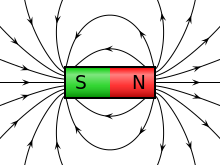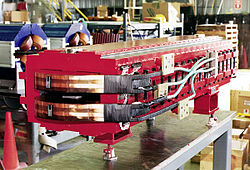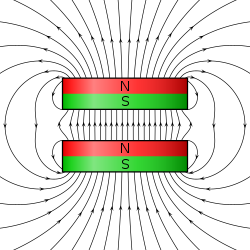
A magnetic field is a physical field that describes the magnetic influence on moving electric charges, electric currents, and magnetic materials. A moving charge in a magnetic field experiences a force perpendicular to its own velocity and to the magnetic field. A permanent magnet's magnetic field pulls on ferromagnetic materials such as iron, and attracts or repels other magnets. In addition, a nonuniform magnetic field exerts minuscule forces on "nonmagnetic" materials by three other magnetic effects: paramagnetism, diamagnetism, and antiferromagnetism, although these forces are usually so small they can only be detected by laboratory equipment. Magnetic fields surround magnetized materials, electric currents, and electric fields varying in time. Since both strength and direction of a magnetic field may vary with location, it is described mathematically by a function assigning a vector to each point of space, called a vector field.

A cyclotron is a type of particle accelerator invented by Ernest Lawrence in 1929–1930 at the University of California, Berkeley, and patented in 1932. A cyclotron accelerates charged particles outwards from the center of a flat cylindrical vacuum chamber along a spiral path. The particles are held to a spiral trajectory by a static magnetic field and accelerated by a rapidly varying electric field. Lawrence was awarded the 1939 Nobel Prize in Physics for this invention.

Synchrotron radiation is the electromagnetic radiation emitted when relativistic charged particles are subject to an acceleration perpendicular to their velocity. It is produced artificially in some types of particle accelerators or naturally by fast electrons moving through magnetic fields. The radiation produced in this way has a characteristic polarization, and the frequencies generated can range over a large portion of the electromagnetic spectrum.

A linear particle accelerator is a type of particle accelerator that accelerates charged subatomic particles or ions to a high speed by subjecting them to a series of oscillating electric potentials along a linear beamline. The principles for such machines were proposed by Gustav Ising in 1924, while the first machine that worked was constructed by Rolf Widerøe in 1928 at the RWTH Aachen University. Linacs have many applications: they generate X-rays and high energy electrons for medicinal purposes in radiation therapy, serve as particle injectors for higher-energy accelerators, and are used directly to achieve the highest kinetic energy for light particles for particle physics.
Accelerator physics is a branch of applied physics, concerned with designing, building and operating particle accelerators. As such, it can be described as the study of motion, manipulation and observation of relativistic charged particle beams and their interaction with accelerator structures by electromagnetic fields.
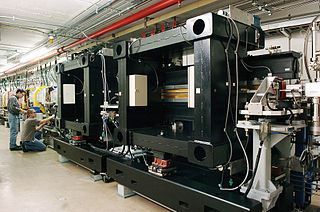
An insertion device (ID) is a component in modern synchrotron light sources, so called because they are "inserted" into accelerator tracks. They are periodic magnetic structures that stimulate highly brilliant, forward-directed synchrotron radiation emission by forcing a stored charged particle beam to perform wiggles, or undulations, as they pass through the device. This motion is caused by the Lorentz force, and it is from this oscillatory motion that we get the names for the two classes of device, which are known as wigglers and undulators. As well as creating a brighter light, some insertion devices enable tuning of the light so that different frequencies can be generated for different applications.

Quadrupole magnets, abbreviated as Q-magnets, consist of groups of four magnets laid out so that in the planar multipole expansion of the field, the dipole terms cancel and where the lowest significant terms in the field equations are quadrupole. Quadrupole magnets are useful as they create a magnetic field whose magnitude grows rapidly with the radial distance from its longitudinal axis. This is used in particle beam focusing.

A synchrocyclotron is a special type of cyclotron, patented by Edwin McMillan in 1952, in which the frequency of the driving RF electric field is varied to compensate for relativistic effects as the particles' velocity begins to approach the speed of light. This is in contrast to the classical cyclotron, where this frequency is constant.

A synchrotron is a particular type of cyclic particle accelerator, descended from the cyclotron, in which the accelerating particle beam travels around a fixed closed-loop path. The magnetic field which bends the particle beam into its closed path increases with time during the accelerating process, being synchronized to the increasing kinetic energy of the particles.
A quadrupole or quadrapole is one of a sequence of configurations of things like electric charge or current, or gravitational mass that can exist in ideal form, but it is usually just part of a multipole expansion of a more complex structure reflecting various orders of complexity.

Electron scattering occurs when electrons are displaced from their original trajectory. This is due to the electrostatic forces within matter interaction or, if an external magnetic field is present, the electron may be deflected by the Lorentz force. This scattering typically happens with solids such as metals, semiconductors and insulators; and is a limiting factor in integrated circuits and transistors.
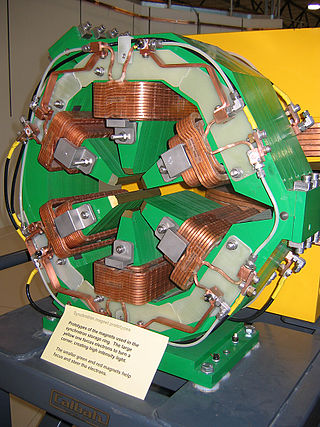
In accelerator physics strong focusing or alternating-gradient focusing is the principle that, using sets of multiple electromagnets, it is possible to make a particle beam simultaneously converge in both directions perpendicular to the direction of travel. By contrast, weak focusing is the principle that nearby circles, described by charged particles moving in a uniform magnetic field, only intersect once per revolution.
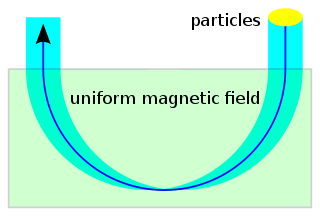
Weak focusing occurs in particle accelerators when charged particles are passing through uniform magnetic fields, causing them to move in circular paths due to the Lorentz force. Because of the circular movement, the orbits of two particles with slightly different positions may approximate or even cross each other.

A particle accelerator is a machine that uses electromagnetic fields to propel charged particles to very high speeds and energies to contain them in well-defined beams. Small accelerators are used for fundamental research in particle physics. Accelerators are also used as synchrotron light sources for the study of condensed matter physics. Smaller particle accelerators are used in a wide variety of applications, including particle therapy for oncological purposes, radioisotope production for medical diagnostics, ion implanters for the manufacture of semiconductors, and accelerator mass spectrometers for measurements of rare isotopes such as radiocarbon.

A sextupole magnet consist of six magnetic poles set out in an arrangement of alternating north and south poles arranged around an axis. They are used in particle accelerators for the control of chromatic aberrations and for damping the head—tail transverse plasma instability. Two sets of sextupole magnets are used in transmission electron microscopes to correct for spherical aberration.

A storage ring is a type of circular particle accelerator in which a continuous or pulsed particle beam may be kept circulating, typically for many hours. Storage of a particular particle depends upon the mass, momentum, and usually the charge of the particle to be stored. Storage rings most commonly store electrons, positrons, or protons.
A Fixed-Field alternating gradient Accelerator is a circular particle accelerator concept that can be characterized by its time-independent magnetic fields and the use of alternating gradient strong focusing.
Magnets exert forces and torques on each other through the interaction of their magnetic fields. The forces of attraction and repulsion are a result of these interactions. The magnetic field of each magnet is due to microscopic currents of electrically charged electrons orbiting nuclei and the intrinsic magnetism of fundamental particles that make up the material. Both of these are modeled quite well as tiny loops of current called magnetic dipoles that produce their own magnetic field and are affected by external magnetic fields. The most elementary force between magnets is the magnetic dipole–dipole interaction. If all magnetic dipoles for each magnet are known then the net force on both magnets can be determined by summing all the interactions between the dipoles of the first magnet and the dipoles of the second magnet.
In accelerator physics, a magnetic lattice is a composition of electromagnets at given longitudinal positions around the vacuum tube of a particle accelerator, and thus along the path of the enclosed charged particle beam. The lattice properties have a large influence on the properties of the particle beam, which is shaped by magnetic fields. Lattices can be closed, linear and are also used at interconnects between different accelerator structures.
The Synchro-Cyclotron, or Synchrocyclotron (SC), built in 1957, was CERN’s first accelerator. It was in circumference and provided for CERN's first experiments in particle and nuclear physics. It accelerated particles to energies up to 600 MeV. The foundation stone of CERN was laid at the site of the Synchrocyclotron by the first Director-General of CERN, Felix Bloch. After its remarkably long 33 years of service time, the SC was decommissioned in 1990. Nowadays it accepts visitors as an exhibition area in CERN.
